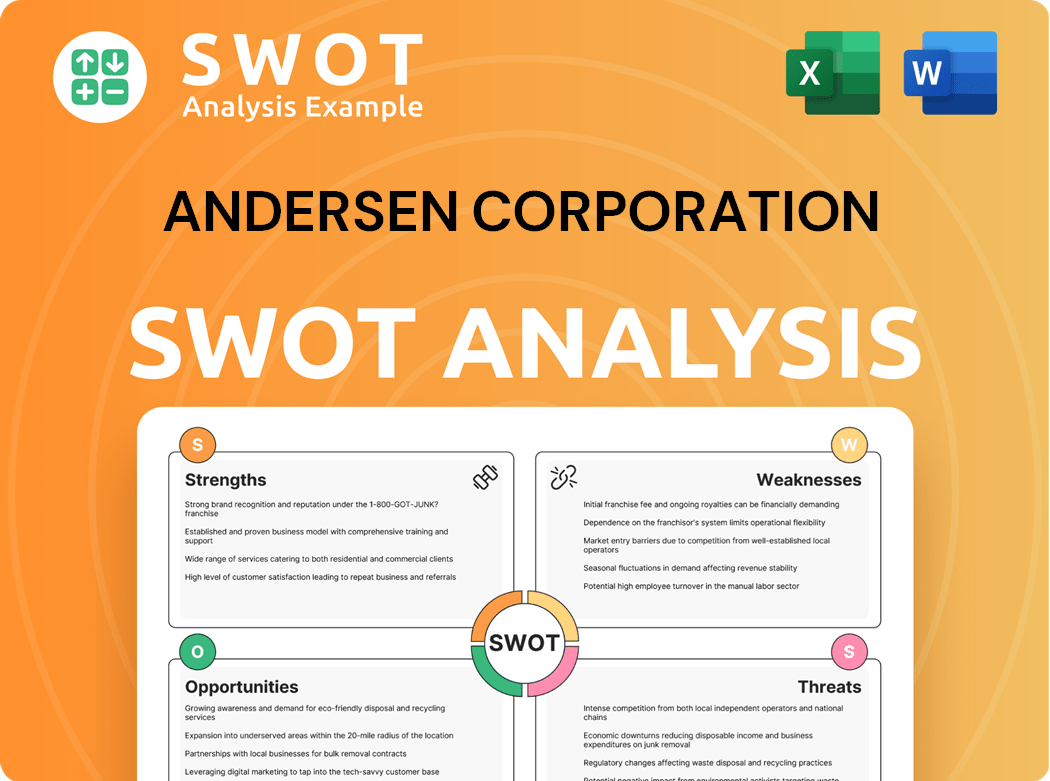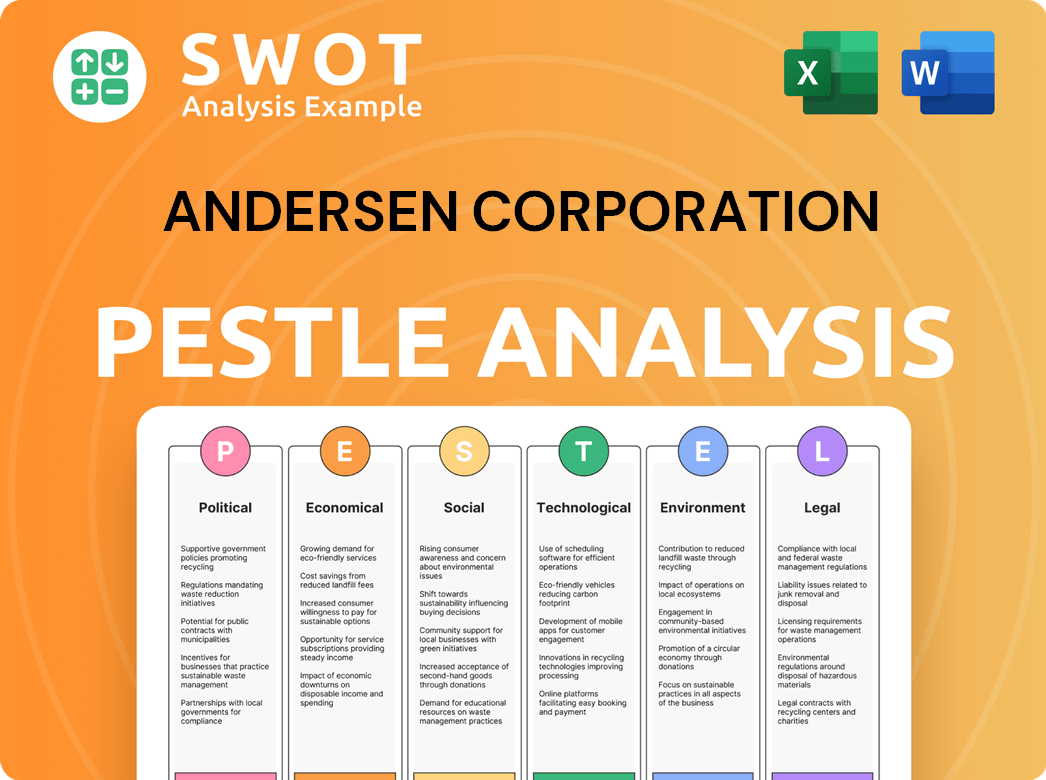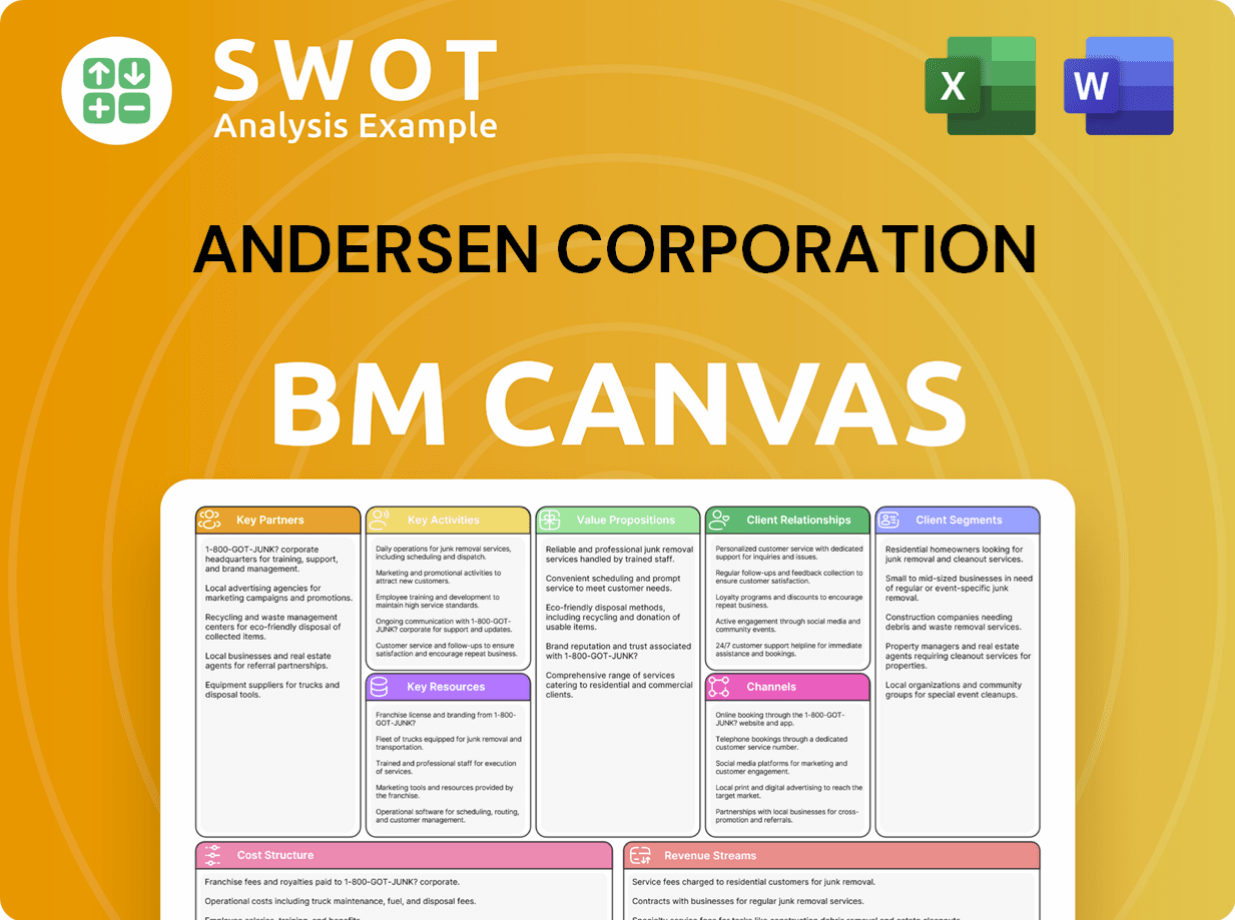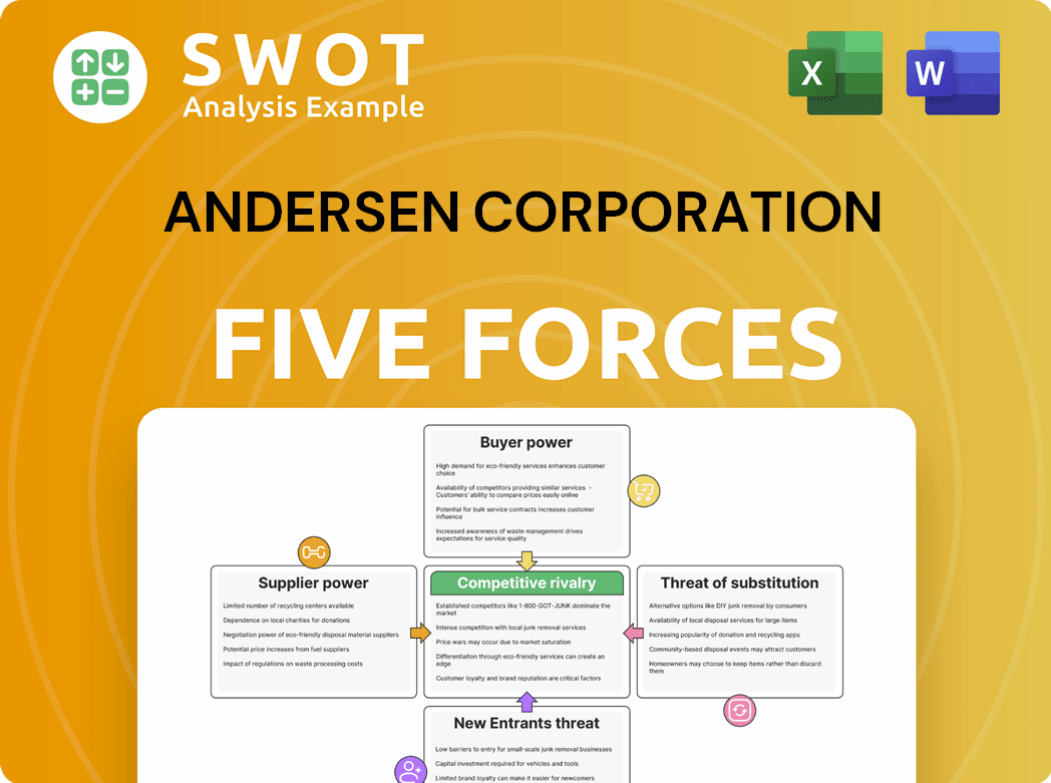Andersen Corporation Bundle
How Does Andersen Corporation Dominate the Window and Door Market?
In an era defined by smart homes and sustainable practices, understanding the Andersen Corporation SWOT Analysis is more crucial than ever. Founded over a century ago, Andersen has evolved from a lumber provider to a building materials titan. This report dives deep into the Andersen Corporation competitive landscape, unraveling the strategies that have solidified its position in the industry.

This comprehensive analysis of the Andersen window market analysis will identify key Andersen Corporation competitors and dissect the competitive advantages that allow Andersen to thrive. We'll explore the impact of industry trends, including the building materials market and home improvement industry, on Andersen's future. Furthermore, we'll address critical questions like "Who are Andersen's main rivals?" and "How does Andersen Corporation compete?" to provide actionable insights for investors and industry professionals alike.
Where Does Andersen Corporation’ Stand in the Current Market?
Andersen Corporation is a major player in the North American window and door industry. It is often considered one of the top two manufacturers, alongside Pella Corporation. The company's core operations involve the design, manufacturing, and distribution of windows, doors, and related products for both residential and commercial markets.
The value proposition of Andersen lies in its focus on quality, innovation, and customer service. They aim to provide durable, energy-efficient, and aesthetically pleasing products that enhance the value and comfort of homes and buildings. This includes a wide range of products, from standard windows and doors to custom designs and replacement options, catering to diverse customer needs and preferences.
Andersen Corporation holds a significant market position within the North American window and door industry. While specific market share figures for 2024-2025 are not publicly available, industry reports consistently place Andersen as a leader. They are particularly strong in the premium and custom window offerings.
Andersen's primary product lines include Andersen windows and doors, Renewal by Andersen replacement windows, and a range of architectural doors and windows. The company focuses on energy efficiency, design flexibility, and advanced materials. They also offer smart home compatibility and sustainable product lines.
Andersen's geographic presence is predominantly North America, with a strong distribution network. This network encompasses independent dealers, national retailers like The Home Depot and Lowe's, and company-owned stores. This extensive network ensures broad market coverage and accessibility for customers.
As a privately held company, detailed financial comparisons are not readily available. However, continued investment in research and development and sustained market presence suggest robust financial health. The company maintains a strong position in the high-end residential new construction and replacement markets.
Andersen Corporation's competitive landscape includes both national and regional players. Key competitors include Pella Corporation, Marvin Windows and Doors, and JELD-WEN. These companies compete on product quality, innovation, brand reputation, and distribution networks. The Growth Strategy of Andersen Corporation involves continuous innovation in product design, material science, and manufacturing processes, to enhance its competitive edge. The company also focuses on expanding its product portfolio, improving its distribution channels, and strengthening its brand presence to maintain a leading position in the market. Andersen's strategic focus on energy-efficient products, smart home integration, and sustainable materials aligns with current market trends, positioning it well for future growth. The company's ability to adapt to changing consumer preferences and technological advancements is crucial for its long-term success.
Andersen's competitive advantages include a strong brand reputation, a wide product range, and an extensive distribution network. The company's focus on innovation, quality, and customer service further enhances its market position. These factors contribute to its ability to attract and retain customers in a competitive market.
- Strong Brand Reputation: Known for quality and durability.
- Extensive Product Range: Offers a wide variety of windows and doors.
- Broad Distribution Network: Reaches customers through multiple channels.
- Focus on Innovation: Continuous improvement in product design and materials.
Andersen Corporation SWOT Analysis
- Complete SWOT Breakdown
- Fully Customizable
- Editable in Excel & Word
- Professional Formatting
- Investor-Ready Format

Who Are the Main Competitors Challenging Andersen Corporation?
The Andersen Corporation competitive landscape is shaped by a diverse set of rivals, both direct and indirect, all vying for market share in the window industry analysis and broader building materials market. Understanding these competitors is crucial for assessing Andersen's market position and formulating effective Andersen Corporation business strategy. The company faces challenges from established players and emerging trends, making continuous adaptation essential for sustained success.
The home improvement industry, where Andersen Corporation operates, is dynamic. The competitive environment is influenced by factors such as product innovation, pricing strategies, distribution networks, and the evolving preferences of consumers. Furthermore, the impact of global supply chains and economic conditions significantly affects the strategies and performance of all players involved. The company's ability to navigate these complexities will determine its ability to maintain and grow its market share.
Andersen's window and door competitors include companies that directly offer similar products. These companies often compete head-to-head in the same market segments. They challenge Andersen through product innovation, competitive pricing, and distribution strategies.
Pella Corporation is a key direct competitor. As a privately held company, Pella offers a comparable range of windows and doors. Pella competes strongly on innovation and product breadth, often engaging in direct battles for market share, particularly in the premium segments.
JELD-WEN is another major direct competitor. JELD-WEN is a publicly traded company with a diverse product portfolio and a broad distribution network. They challenge Andersen through competitive pricing and extensive reach, making them a significant player in the market.
Masonite, while primarily focused on doors, is increasingly offering integrated entry solutions. This expansion puts them in direct competition with Andersen, particularly in the market for complete door systems. Masonite competes through product development and distribution.
Andersen Corporation competitors also include indirect rivals that may offer alternative solutions or compete in different segments of the market. These competitors can impact Andersen's market position through pricing, regional advantages, or specialized offerings.
Regional manufacturers offer localized advantages in service and customization. While smaller in scale, these companies can provide tailored solutions and build strong local relationships, posing a competitive threat in specific geographic areas.
The Andersen Corporation competitive landscape is further complicated by the availability of imported windows and doors, primarily from Asia and Europe, which present a pricing challenge. Additionally, companies specializing in specific components, such as glass manufacturers or hardware suppliers, can partner with smaller assemblers to create competing products. Mergers and acquisitions within the building materials sector also reshape the competitive dynamics, potentially leading to stronger, more diversified competitors. Emerging players focusing on niche markets, like ultra-energy-efficient windows or smart window technologies, could disrupt the traditional landscape. For more insights into the company's history, you can read a Brief History of Andersen Corporation.
Several factors influence the competitive dynamics in the window and door market. Understanding these factors is crucial for Andersen's market share analysis and strategic planning.
- Product Innovation: Continuous development of new features, materials, and designs to meet evolving consumer preferences.
- Pricing Strategy: Offering competitive prices to attract customers, considering production costs, market rates, and competitor pricing.
- Distribution Network: Establishing efficient channels to ensure product availability and reach a wide customer base.
- Customer Service: Providing excellent customer support, including installation, maintenance, and warranty services.
- Brand Reputation: Building a strong brand image through quality, reliability, and customer satisfaction.
Andersen Corporation PESTLE Analysis
- Covers All 6 PESTLE Categories
- No Research Needed – Save Hours of Work
- Built by Experts, Trusted by Consultants
- Instant Download, Ready to Use
- 100% Editable, Fully Customizable

What Gives Andersen Corporation a Competitive Edge Over Its Rivals?
The competitive landscape for Andersen Corporation is shaped by its robust competitive advantages, including brand equity, product innovation, and an extensive distribution network. These factors allow the company to maintain a strong market position within the window and door industry. Understanding these strengths is crucial for assessing the company's ability to sustain its performance and navigate challenges from rivals.
Andersen Corporation's strategic moves and competitive edge are significantly influenced by its continuous investment in research and development, which leads to the introduction of energy-efficient products. Furthermore, the company's multi-channel distribution strategy, encompassing dealers, retailers, and a dedicated replacement division, ensures broad product availability and customer access. This approach is a significant barrier to entry for new competitors.
The company's financial performance and market position are also key indicators of its competitive stance. Analyzing these aspects provides a comprehensive view of how Andersen Corporation competes in the market and its prospects for future growth. For a deeper dive into the company's ownership structure, you can explore Owners & Shareholders of Andersen Corporation.
Andersen's brand is synonymous with quality and durability, fostering strong customer loyalty. This brand recognition allows the company to command premium pricing in certain market segments. The company's long-standing reputation, built over more than a century, provides a significant competitive advantage.
Andersen consistently invests in research and development, leading to innovative products like Fibrex composite material. The company holds numerous patents for its window and door technologies, providing a proprietary edge. This focus on innovation allows Andersen to meet evolving consumer demands and maintain a competitive advantage.
Andersen's vast distribution network, including thousands of independent dealers and national retailers, ensures widespread product availability. The dedicated replacement division, Renewal by Andersen, further enhances customer access. This multi-channel approach creates a significant barrier to entry for new competitors.
Economies of scale allow Andersen to optimize manufacturing processes and supply chain logistics. This leads to cost efficiencies that smaller competitors struggle to match. These efficiencies contribute to the company's ability to compete effectively in terms of pricing and profitability.
Andersen Corporation's competitive advantages are multifaceted, contributing to its strong position in the window industry. These strengths include a well-established brand, continuous product innovation, and a robust distribution network. These elements work together to create a sustainable competitive edge.
- Brand Recognition: The Andersen brand is highly recognized and trusted, allowing for premium pricing.
- Product Innovation: Investments in R&D lead to energy-efficient and durable products.
- Distribution Network: A vast network ensures widespread product availability and customer access.
- Economies of Scale: Optimized manufacturing processes and supply chain logistics drive cost efficiencies.
Andersen Corporation Business Model Canvas
- Complete 9-Block Business Model Canvas
- Effortlessly Communicate Your Business Strategy
- Investor-Ready BMC Format
- 100% Editable and Customizable
- Clear and Structured Layout

What Industry Trends Are Reshaping Andersen Corporation’s Competitive Landscape?
The window and door industry, where Andersen Corporation operates, is experiencing significant shifts driven by technological advancements, sustainability concerns, and evolving consumer preferences. Understanding the Andersen Corporation competitive landscape requires an analysis of these trends and how they impact the company's strategic positioning. Key factors influencing the market include the adoption of smart home technologies, stringent energy efficiency regulations, and the demand for eco-friendly building materials. For a deeper understanding, consider exploring the Target Market of Andersen Corporation.
Andersen faces both opportunities and challenges. Economic downturns and supply chain disruptions pose risks, while the rising demand for innovative, sustainable products offers growth potential. Competitors' actions and market dynamics necessitate a proactive approach to maintain and enhance market share. The company's financial performance and strategic initiatives are crucial for navigating these complexities.
The window industry is seeing increased demand for energy-efficient and smart-home-integrated products. Sustainability is a major driver, with consumers and regulators pushing for eco-friendly materials and practices. Customization and aesthetic appeal are also important considerations for buyers.
Economic downturns can significantly impact new construction and remodeling, affecting sales. Competition from global manufacturers offering lower-cost alternatives is a persistent challenge. Supply chain disruptions and the need for resilient sourcing strategies are crucial.
Emerging markets, particularly in developing economies, offer significant growth potential. Product innovation in areas like electrochromic glass and integrated renewable energy presents differentiation opportunities. Strategic partnerships can unlock new revenue streams.
Andersen is expected to focus on expanding smart product offerings and optimizing the supply chain for resilience. Exploring new geographical markets and investing in innovation will be key to maintaining a competitive edge. Adaptation is crucial.
The window industry is influenced by factors such as economic conditions, consumer preferences, and technological advancements. Andersen needs to adapt to these changes to remain competitive. The company's success will depend on its ability to innovate and respond to market demands.
- Market Dynamics: The building materials market is sensitive to economic cycles; downturns can impact demand.
- Competitive Pressure: Andersen faces competition from established rivals like Pella and emerging players in the smart home space.
- Sustainability: The demand for eco-friendly products and compliance with green building standards are growing.
- Innovation: Developing smart windows, advanced insulation, and integrating renewable energy features are key.
Andersen Corporation Porter's Five Forces Analysis
- Covers All 5 Competitive Forces in Detail
- Structured for Consultants, Students, and Founders
- 100% Editable in Microsoft Word & Excel
- Instant Digital Download – Use Immediately
- Compatible with Mac & PC – Fully Unlocked

Related Blogs
- What are Mission Vision & Core Values of Andersen Corporation Company?
- What is Growth Strategy and Future Prospects of Andersen Corporation Company?
- How Does Andersen Corporation Company Work?
- What is Sales and Marketing Strategy of Andersen Corporation Company?
- What is Brief History of Andersen Corporation Company?
- Who Owns Andersen Corporation Company?
- What is Customer Demographics and Target Market of Andersen Corporation Company?
Disclaimer
All information, articles, and product details provided on this website are for general informational and educational purposes only. We do not claim any ownership over, nor do we intend to infringe upon, any trademarks, copyrights, logos, brand names, or other intellectual property mentioned or depicted on this site. Such intellectual property remains the property of its respective owners, and any references here are made solely for identification or informational purposes, without implying any affiliation, endorsement, or partnership.
We make no representations or warranties, express or implied, regarding the accuracy, completeness, or suitability of any content or products presented. Nothing on this website should be construed as legal, tax, investment, financial, medical, or other professional advice. In addition, no part of this site—including articles or product references—constitutes a solicitation, recommendation, endorsement, advertisement, or offer to buy or sell any securities, franchises, or other financial instruments, particularly in jurisdictions where such activity would be unlawful.
All content is of a general nature and may not address the specific circumstances of any individual or entity. It is not a substitute for professional advice or services. Any actions you take based on the information provided here are strictly at your own risk. You accept full responsibility for any decisions or outcomes arising from your use of this website and agree to release us from any liability in connection with your use of, or reliance upon, the content or products found herein.